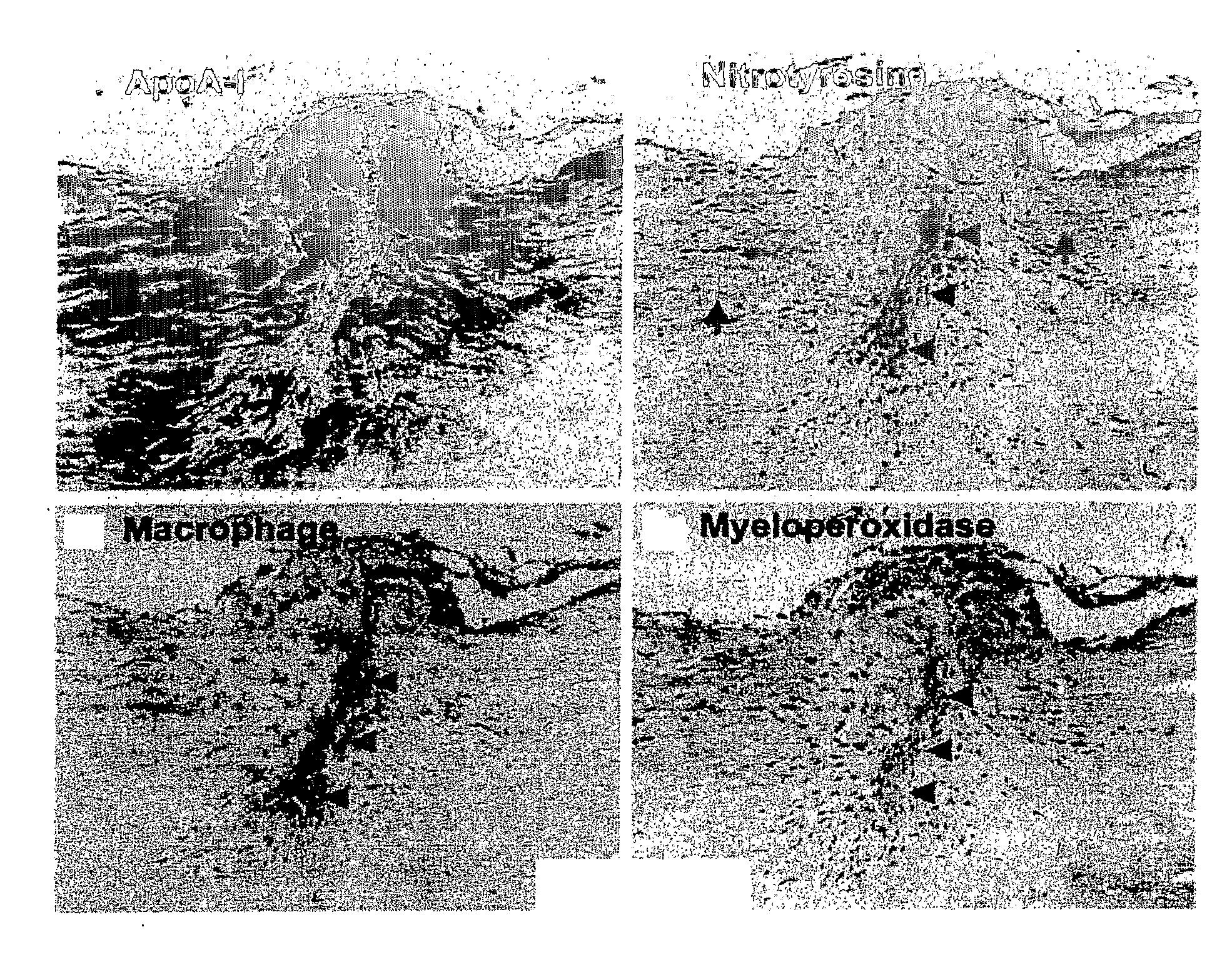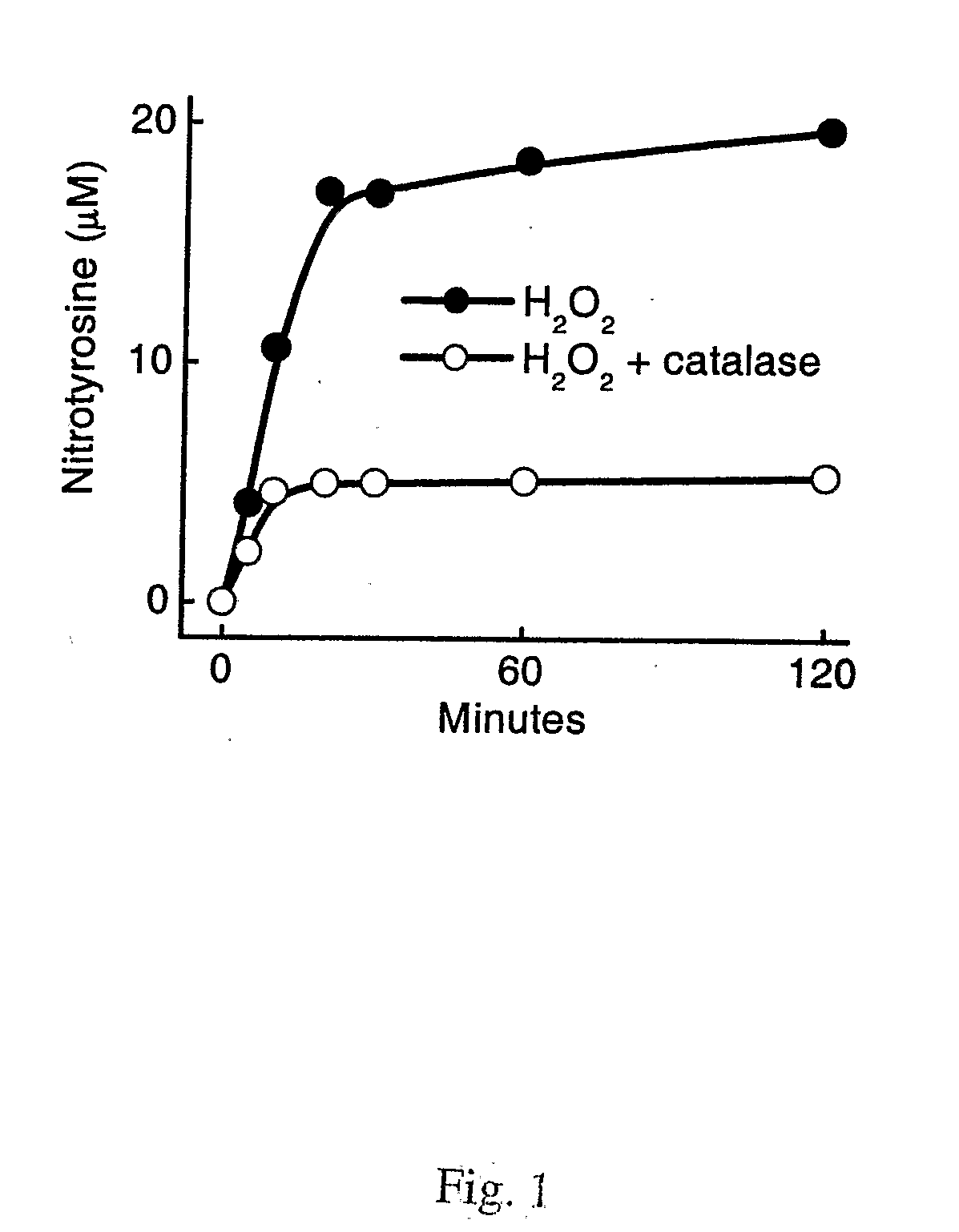Methods for Assessing the Risk for Development of Cardiovascular Disease
- Summary
- Abstract
- Description
- Claims
- Application Information
AI Technical Summary
Benefits of technology
Problems solved by technology
Method used
Image
Examples
example 1
Materials
[0102]Myeloperoxidase (donor: hydrogen peroxide, oxidoreductase, EC 1.11.1.7) was isolated by lectin affinity and size exclusion chromatographies from human neutrophils (Heinecke et al, (1993) Journal of Biological Chemistry 268, 4069-4077; Hope et al., (2000) Protein Expr Purif 18, 269-276) and stored at −20° C. Purified enzyme had an A430 / A280 ratio of 0.8 and was apparently homogeneous on SDS-PAGE analysis; its concentration was determined spectrophotometrically (ε430=0.17 M−1 cm−1) (Morita et al., (1986) J. Biochem. 99, 761-770). Cambridge Isotope Laboratories (Andover, Mass.) supplied 13C-labeled amino acids. 3-Nitro[13C6]tyrosine was synthesized using tetranitromethane under basic conditions, and its concentration was determined by comparison with authentic material during reverse-phase HPLC (Pennathur et al., (2001) J Clin Invest 107, 853-860). Sodium hypochlorite (NaOCl), trifluoroacetic acid (TFA), and HPLC-grade CH3CN and methanol were obtained from Fisher Scienti...
example 2
[0128]Materials. Cambridge Isotope Laboratories (Andover, Mass.) supplied 13C-labeled amino acids. 3-Chloro[13C6]tyrosine was synthesized using HOCl under acidic conditions, and its concentration was determined by comparing it with authentic material in reverse-phase HPLC (Gaut et al., 2002. Anal Biochem 300:252-259.). All organic solvents were HPLC grade. Carotid endarterectomy tissue was supplied by the Division of Vascular Surgery, Bowman Grey School of Medicine. Vascular tissue resected at surgery was immediately frozen at −80° C. until analysis.
[0129]Protein Oxidation Reactions. Reactions were carried out at 37° C. in PBS (10 mM sodium phosphate, 138 mM NaCl, 2.7 mM KCl, pH 7.4) supplemented with 1 mg / mL HDL protein. Reactions were initiated by adding oxidant and terminated by adding a 10- to 50-fold molar excess of L-methionine. Concentrations of HOCl and H2O2 were determined spectrophotometrically (ε292=350 M−1 cm−1 and ε240=39.4 M−1 cm−1) (Morris, 1966. J Phys Chem 70:3798-3...
example 3
[0153]Approximately 40% of renal transplants are performed in diabetics. These patients are at high risk for atherosclerosis and approximately 50% of the transplants are lost due to cardiovascular mortality in these patients despite acceptable renal graft function. Kidney disease has been linked to risk of recurrent cardiovascular disease and mortality. See, Shlipak et al, NEJM, (2004) 352(20):2049; Coresh et al., (2005) Circulation and Hemodynamics 10:73; Weiner et al., American Journal of Kidney Diseases (2004) 44(2):198; Anavekar et al., (2004) NEJM 351(13):1285; Go et al., NEJM (2004) 351(13):1296. We postulated that oxidative stress is increased in the diabetic renal transplant patient population.
Methods
[0154]We divided a study population into 2 groups according to non-diabetic control patients who have undergone a renal transplant and diabetic patients who have undergone a renal transplant. Ten patients were included in each group. Serum creatinine levels were measured for pat...
PUM
 Login to View More
Login to View More Abstract
Description
Claims
Application Information
 Login to View More
Login to View More - R&D
- Intellectual Property
- Life Sciences
- Materials
- Tech Scout
- Unparalleled Data Quality
- Higher Quality Content
- 60% Fewer Hallucinations
Browse by: Latest US Patents, China's latest patents, Technical Efficacy Thesaurus, Application Domain, Technology Topic, Popular Technical Reports.
© 2025 PatSnap. All rights reserved.Legal|Privacy policy|Modern Slavery Act Transparency Statement|Sitemap|About US| Contact US: help@patsnap.com



